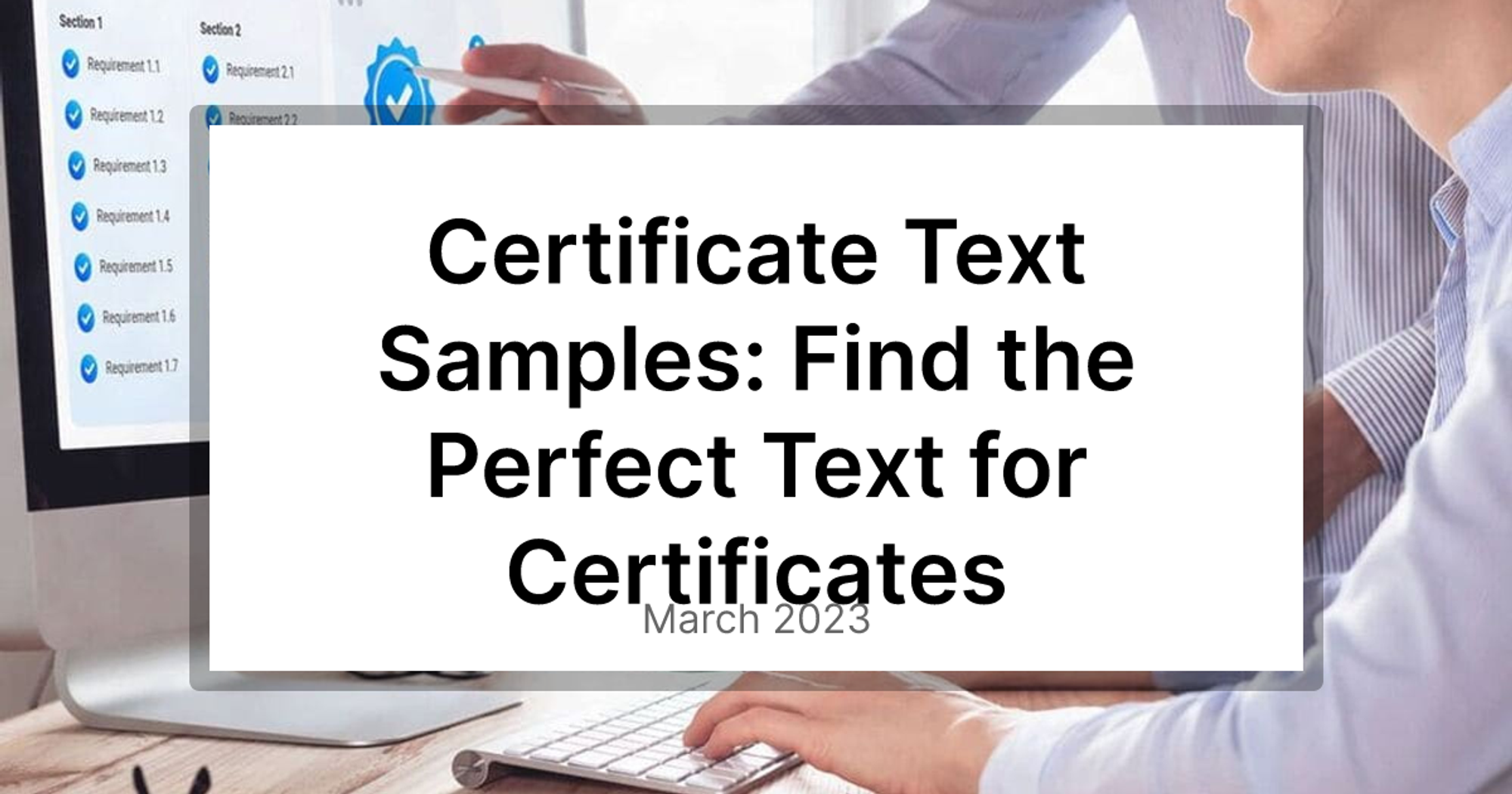Introduction

Certificates are more than just pieces of paper. They are symbols of recognition, appreciation, achievement, and trust. They can boost the morale, motivation, and loyalty of your employees, customers, partners, students, or members. They can also enhance your brand image, reputation, and credibility.
But how do you make your certificates stand out from the crowd? How do you make them look professional, elegant, and memorable? How do you make them reflect your brand identity, values, and personality?
One of the most important factors that influence the look and feel of your certificates is the font. The font is the style and appearance of the text on your certificates. It can convey a certain mood, tone, or message to your recipients. It can also affect the readability, legibility, and attractiveness of your certificates.
That’s why choosing the right font for your certificates is crucial. You want to pick a font that matches your brand voice and style, as well as the purpose and context of your certificates. You also want to use a font that is easy to read and understand, as well as aesthetically pleasing and eye-catching.
But how do you choose and use certificate fonts effectively? What are the different types of certificate fonts and how do they differ? Where can you find the best free and premium certificate fonts for your brand?
In this blog post, we will answer all these questions and more. We will cover everything you need to know about certificate fonts, including:
- What are certificate fonts and why do they matter for your brand?
- The different types of certificate fonts and how to choose the best one for your purpose.
- How to use certificate fonts effectively for your certificate design and layout.
- The best free and premium certificate fonts to download and use for your brand.
- Certificate font examples and inspiration from top brands and organizations.
By the end of this blog post, you will have a clear understanding of certificate fonts and how to use them for your brand. You will also have access to a list of resources where you can find the best certificate fonts for your needs.
So let’s get started with learning more about certificate fonts!
What are Certificate Fonts?

Certificate fonts are the fonts that you use for your certificates, awards, diplomas, and other documents that recognize achievements or qualifications. They are usually formal, elegant, and decorative fonts that create a sense of prestige, honor, and quality.
Certificate fonts matter for your brand because they can:
- Create a lasting impression: Your certificates are not only meant to be seen once by your recipients. They are also meant to be displayed proudly on walls, desks, or portfolios. They are meant to be shown off to others who might see them. That’s why you want to make sure that your certificates look impressive and memorable. You want them to catch the attention of anyone who sees them and make them curious about your brand.
- Communicate your brand message: Your certificates are not only meant to convey information about the achievement or qualification of your recipients. They are also meant to convey information about your brand identity, values, and personality. You want them to reflect what your brand stands for and what makes it unique. You want them to express your brand voice and style in a consistent and coherent way.
- Build trust and credibility: Your certificates are not only meant to reward or acknowledge your recipients. They are also meant to establish or strengthen a relationship with them. You want them to feel valued, appreciated, and respected by your brand. You want them to trust your brand as a reliable and reputable source of recognition or certification. You want them to associate your brand with quality, excellence, and professionalism.
As you can see, certificate fonts play a vital role in creating effective certificates that can benefit your brand in many ways. That’s why you need to choose them carefully and wisely.
Different Types of Certificate Fonts

There are many types of fonts that you can use for your certificates, but they can be broadly categorized into four main groups:
- Serif fonts: Serif fonts are fonts that have small strokes or lines at the ends of the letters. They are the most traditional and classic type of fonts for certificates. They create a sense of elegance, sophistication, and authority. They are also easy to read and scan, especially in print. Some examples of serif fonts are Merriweather, Playfair Display, and Lora.
- Sans serif fonts: Sans serif fonts are fonts that do not have strokes or lines at the ends of the letters. They are the most modern and minimalist type of fonts for certificates. They create a sense of simplicity, clarity, and freshness. They are also versatile and adaptable, especially for digital use. Some examples of sans serif fonts are Montserrat, Open Sans, Raleway, and Nunito.
- Script fonts: Script fonts are fonts that mimic handwriting or calligraphy. They are the most decorative and artistic type of fonts for certificates. They create a sense of personality, creativity, and flair. They are also expressive and unique, especially for personal or informal use. Some examples of script fonts are Pinyon Script, Parisienne, Herr Von Muellerhoff and Italianno.
- Blackletter fonts: Blackletter fonts are fonts that resemble medieval or Gothic manuscripts. They are the most ornate and dramatic type of fonts for certificates. They create a sense of history, tradition, and prestige. They are also distinctive and eye-catching, especially for ceremonial or formal use. Some examples of blackletter fonts are Old English Text MT, UnifrakturMaguntia, UnifrakturCook, New Rocker, and Germania One.
- Display fonts: Display fonts are fonts that have distinctive and decorative features that make them stand out. They are the most expressive and creative type of fonts for certificates. They create a sense of personality, style, and flair. They are also attention-grabbing and memorable, especially for unique or special occasions. Some examples of display fonts are Lobster, Abril Fatface, Bangers, and Comic Sans.
How do you choose the best type of font for your certificate? Here are some tips to help you:
- Consider your brand identity: You want to choose a font that matches your brand voice and style. You want to choose a font that reflects your brand personality and values. For example, if your brand is elegant and sophisticated, you might want to choose a serif font. If your brand is simple and modern, you might want to choose a sans serif font.
- Consider your certificate purpose: You want to choose a font that suits your certificate goal and context. You want to choose a font that conveys the appropriate mood and tone for your certificate. For example, if your certificate is for an academic achievement, you might want to choose a serif or blackletter font. If your certificate is for a creative achievement, you might want to choose a script or sans serif font.
- Consider your certificate design: You want to choose a font that complements your certificate layout and elements. You want to choose a font that balances your certificate aesthetics and functionality. For example, if your certificate has a lot of text, you might want to choose a font that is easy to read and scan. If your certificate has a lot of graphics, you might want to choose a font that is simple and clean.
By following these tips, you can narrow down your options and find the best type of font for your certificate.
How to Use Certificate Fonts Effectively

Choosing the right type of font for your certificate is not enough. You also need to use it effectively for your certificate design and layout. Here are some best practices to help you:
- Use one main font for your certificate title: Your certificate title is the most important part of your certificate. It is the first thing that your recipients and viewers will see and read. It is also the part that conveys the main message and value of your certificate. That’s why you need to use one main font for your certificate title that is prominent, clear, and attractive.
- Use different font sizes for different parts of your certificate: Your certificate has different parts that have different levels of importance and relevance. For example, your certificate title is more important than your certificate subtitle or body text. That’s why you need to use different font sizes for different parts of your certificate that reflect their hierarchy and priority.
- Use different font styles or weights for contrast and emphasis: Your certificate may have some parts that need more contrast or emphasis than others. For example, you may want to highlight the name of your recipient or the name of your brand more than other parts of your certificate text. That’s why you need to use different font styles or weights for contrast and emphasis that make them stand out more.
- Use different font colors for harmony and variety: Your certificate may have some parts that need more harmony or variety than others. For example, you may want to match the color of your font with the color of your logo or background more than other parts of your certificate text. That’s why you need to use different font colors for harmony and variety that make them blend in or pop out more.
- Use one or two complementary fonts for your certificate text: Your certificate text is the part that provides more details and information about your certificate title. It may include the name of your recipient, the name of your brand, the date and place of issuance, the signature and seal of authority, and any other relevant text. That’s why you need to use one or two complementary fonts for your certificate text that are easy to read and understand, and that match well with your main font.
By following these best practices, you can use certificate fonts effectively for your certificate design and layout.
Inspiration from Top Brands and Organizations

To give you some more ideas and inspiration on how to use certificate fonts for your brand, here are some examples of certificates from top brands and organizations that use different types of certificate fonts:
- Apple: Apple uses a sans serif font (Helvetica Neue) for its Apple Teacher Recognition Certificate. The font is simple, modern, and minimalist, which matches Apple’s brand identity and style. The font is also easy to read and scan, which makes the certificate clear and concise.
- Starbucks: Starbucks uses a script font Brush Script MT for its Starbucks Coffee Master Certificate. The font is decorative, artistic, and expressive, which matches Starbucks’ brand personality and values. The font is also unique and eye-catching, which makes the certificate stand out and memorable.
- Harvard University: Harvard University uses a blackletter font Old English Text MT for its Harvard College Diploma. The font is ornate, dramatic, and prestigious, which matches Harvard’s brand history, tradition, and reputation. The font is also distinctive and impressive, which makes the certificate authoritative and honorable.
- Nike: Nike uses a serif font Garamond for its Nike Employee Recognition Certificate. The font is elegant, sophisticated, and classic, which matches Nike’s brand image, quality, and professionalism. The font is also versatile and adaptable, which makes the certificate suitable for different purposes and contexts.
- Coursera: Coursera uses a slab serif font Enriqueta for its Coursera Course Certificate. The font is modern, bold, and friendly, which matches Coursera’s brand mission, vision, and values. The font is also legible and attractive, which makes the certificate easy to understand and share.
These are some examples of certificates from top brands and organizations that use different types of certificate fonts. You can use them as references or models for your own certificates.
Simplify Your Certificate Issuance with Certopus
Choosing and using the right font for your certificates is important, but it’s not the only thing you need to consider. You also need to think about how to create, manage, and distribute your certificates in an efficient and secure way.
If you’re looking for a solution that can help you simplify your certificate issuance in all aspects, we have a valuable advice for you: check out Certopus.
Certopus is a digital credentials platform that lets you create, issue, and verify digital certificates with ease.

With Certopus, you can:
- Create beautiful and professional certificates. You can use Certopus’ user-friendly editor to design your certificates from scratch, or choose from hundreds of ready-made templates that suit your needs. You can also customize your certificates with your own logo, colors, fonts, images, and more.
- Issue certificates in bulk or individually. You can upload your recipients’ data from a spreadsheet or an API, and issue certificates to them in seconds. You can also issue certificates individually by entering the recipient’s name and email address. You can choose to send the certificates via email or download them as PDF files.
- Verify certificates online. You can generate unique QR codes or URLs for each certificate, and embed them on your certificates. This way, anyone who scans or clicks on them can verify the authenticity and validity of your certificates online. You can also track and manage your issued certificates with ease.
- Integrate with your favorite tools. You can connect Certopus with your favorite tools and platforms, such as Zoom, Canvas LMS, Moodle, Thinkific, Microsoft Power Automate, Zapier, and more. This way, you can automate your certificate issuance process and streamline your workflow.
Frequently Asked Questions ( FAQ )
What is the best font size for certificates?
It depends on various factors, such as the type of font, the amount of text, the size of the paper, the resolution of the printer, etc. However, a general rule of thumb is to use a larger font size for your certificate title (around 36 to 48 points), a medium font size for your certificate subtitle or body text (around 18 to 24 points), and a smaller font size for your certificate footer or fine print (around 10 to 12 points).
How many fonts should I use for my certificate?
A general rule of thumb for number of fonts is to use no more than three fonts for your certificate: one main font for your certificate title, one or two complementary fonts for your certificate text. Using too many fonts can make your certificate look cluttered, confusing, and unprofessional.
Where can I find free certificate templates?
If you want to create your own certificates with your own fonts, you may need some certificate templates that you can customize and edit. There are many websites and platforms that offer free certificate templates that you can use for personal or commercial use. One of the platform is Certopus.
Need more information?
Book a demo to learn more about Certopus for your business use-case, or if you have any questions, please contact us. We would be delighted to assist you. Finally, if you're on social media, follow us to remain informed about our latest developments and to learn more about digital credentials like digital certificates, digital badges and micro-credentials.
Recommended Articles:
_(1)_(1).jpeg?table=block&id=fd032b8e-420b-41a1-ac1d-8878373df3bb&cache=v2)


